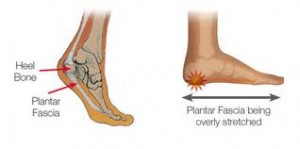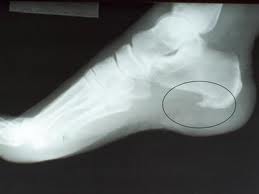 Contrary to what you may think, a heel spur is not a star-shaped, metal device that cowboys wear on the heels of their boots in order to prod their horse to pick up the pace. A heel spur is actually an abnormal bony growth on the heel bone. Although this bone is usually smooth, it can press or rub against other bones, ligaments, tendons, or nerves in the foot, leading to wear and tear of the tissue over time, swelling and heel pain. Corns and calluses may develop over the bone spur as the tissue builds up.
Contrary to what you may think, a heel spur is not a star-shaped, metal device that cowboys wear on the heels of their boots in order to prod their horse to pick up the pace. A heel spur is actually an abnormal bony growth on the heel bone. Although this bone is usually smooth, it can press or rub against other bones, ligaments, tendons, or nerves in the foot, leading to wear and tear of the tissue over time, swelling and heel pain. Corns and calluses may develop over the bone spur as the tissue builds up.
What Causes Heel Spurs?
The most common cause of heel spurs is due to calcium deposits forming when the plantar fascia pulls away from the heel. The plantar fascia is a broad band of connective tissue running along the bottom of the foot from the heel to the toes. This stretching of the plantar fascia is usually the result of overpronation, which can be caused by:
- Age
- Tight ligaments
- Being overweight
- Certain activities like running or dancing
People with high arches can also develop heel spurs. Women who frequently wear high heels are more likely to develop heel spurs. Also, women who wear shoes that are too tight can develop a bone spur due to increased pressure on the back of the heel.
How Is a Heel Spur Diagnosed?
If you’re experiencing heel pain, especially when walking, you should visit your doctor. A heel spur is usually identified by an X-ray. A heel spur can actually get up to half an inch long and look like a hook coming out of your heel. It can cause pain when the soft tissues around it become inflamed, or it begins to compress the nerves in the area. Your doctor will also examine the spur to rule out other conditions, such as fractures or arthritis.
How Is a Heel Spur Treated?
Since a heel spur can cause the soft tissue inflammation, treatment is directed toward relieving tension and irritation of the plantar fascia, as well as determining if there is damage to other tissues.
Treatment may involve:
- Resting the foot until pain subsides.
- Applying ice to the heel to reduce inflammation.
- Performing exercises to stretch the heel and bottom of the foot.
- Taking nonsteroidal anti-inflammatory medications, such as ibuprofen, for pain and swelling.
- Wearing heel pads or custom orthotics, like the ezWalker® Performance Insole, to reduce overpronation and tension on the plantar fascia since your feet will be better bio-mechanically aligned, controlling each step as you walk. Available without a prescription, this custom-made insole reduces the amount of shock and shear forces the footexperiences from everyday activities by supporting the arch and controlling the heel.
- Weightloss to take stress and pressure off of the foot.
- Wearing properly fitted shoes.
- Corticosteroid injections.
- Surgery to remove the bone spur.
For more information on how ezWalker® Performance Insoles can improve your foot mechanics, contact us today. We’re so confident that you’ll experience a substantial improvement in walking comfort that we offer a 90-day, 100% money-back guarantee. So what do you have to lose – except your pain? Visit our online shop to purchase your ezWalker® Performance Insoles today.
Remember … when your feet feel good, you feel good.
Note: If you follow these guidelines and your pain persists, you may have a more serious condition. See your physician for a more complete diagnosis and treatment.

